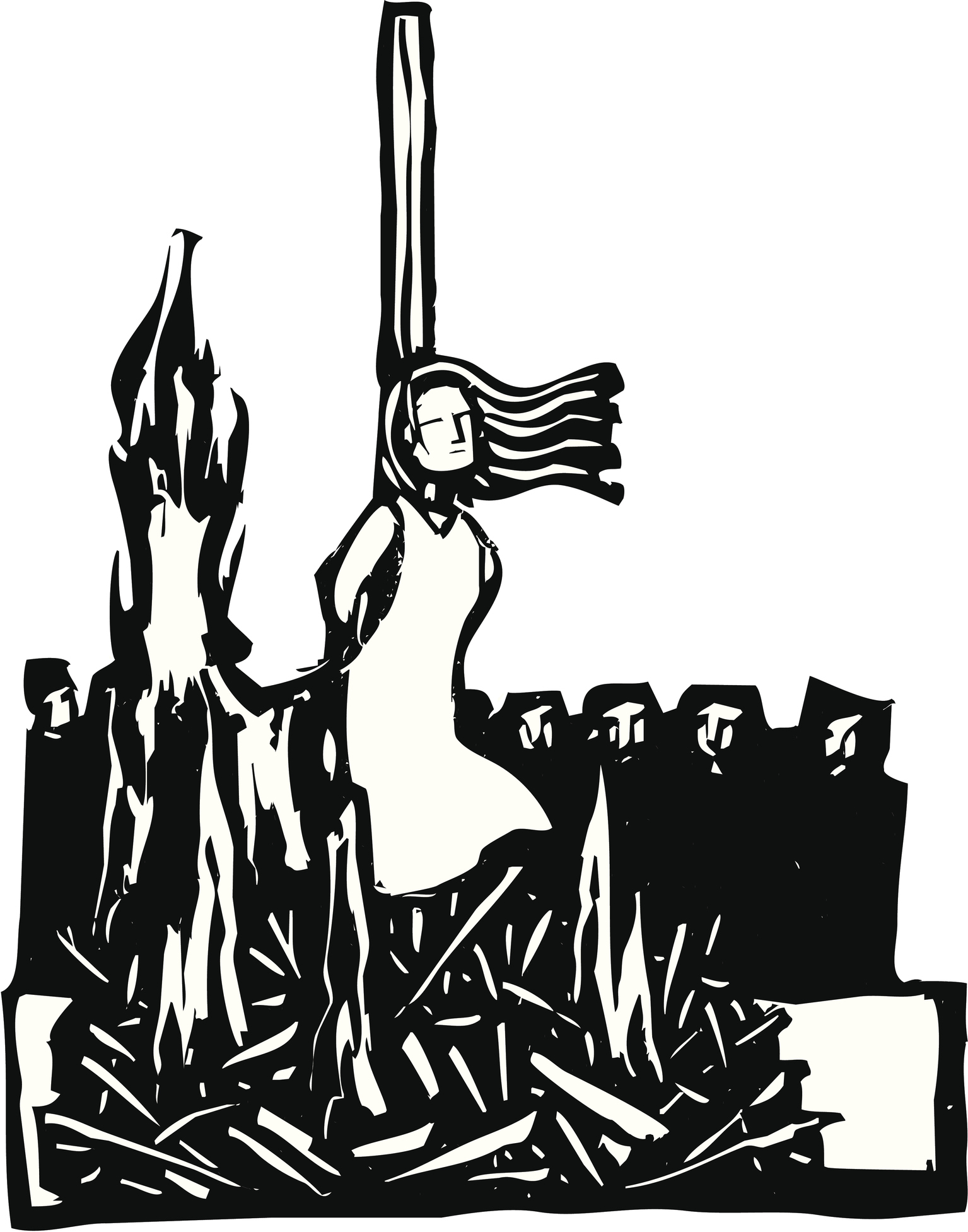Elites dissemble, but people are hungry for a new, fully free university.
Minerva Has Left the Building

The era of wisdom on campus is over.
On a recent trip to Italy, one ancient edifice out of all the rest commanded my special attention. For hundreds of years, the Assisi church of Santa Maria sopra Minerva was a place of worship to the pagan gods and goddesses. Now for nearly two thousand it has housed a Christian church. With its Corinthian columns, the building appears unchanged from its pagan origin. The statue inside of the female figure—once Minerva, the goddess of wisdom—could have merely been renamed Mary, Mother of God. Kierkegaard observed that the true revolution leaves all the buildings and symbols right where they are but changes all their meanings. This is what happened to paganism under Christianity in the West, at least at this temple. The Italian women praying in the dark before the statue testified to the total transition of meaning from pagan light to Christian sanctity. No one worshipped Minerva here anymore.
Just such a revolution is happening now in higher education. The campuses are still there. Students still apply and get in. Courses are conducted; knowledge is transferred and degrees conferred. But none of that means what it once did.
We have seen in recent campus protests a group of students so slavishly political that their education amounts to little more than puppeteering. These youthful fires have been stoked by faculty who want change and think that teaching is no more than string-pulling. But excitable youth and frustrated teachers are as old as time. The revolution that I am referring to is not the result of any particular bad actors. It is not the few tenured radicals, or the vocal woke students. It is not a few elite institutions. Rather the whole enterprise is rotten. From financing, to administration, to recruiting, to instruction, to accreditation, there is a tunneling wound in American higher education that I fear is fatal. Some institutions will collapse from the rot like the Temple of Caesar, now a mere pile of bricks in the Roman Forum. Others, like the Temple of Minerva, will continue to exist, but fundamentally transformed.
Eighty years ago H.G. Wells wrote, “We are living in 1937, and our universities, I suggest, are not half-way out of the fifteenth century. We have made hardly any changes in our conception of university organization, education, graduation, for a century—for several centuries.” Yet if Wells were around today, I suspect he’d be quite pleased. Our universities are well out of the fifteenth century. So what has changed between now and then? And why has it happened?
The Triumph of the Functionaries
To understand a beast we must look to the head that guides it. In higher education that head is the administration. In the beginning, “administration” meant the servants of the university. The actual university was the faculty and the students. The administrators were there to do the dirty managerial and financial jobs that would get in the way of the truly noble research and teaching. These functionaries were put in place by the faculty, they were generally drawn from the faculty, and at the end of their term they would return to the faculty. It was a conception of the ruler who rules for the benefit of the ruled—of the philosopher who would not rule if there were anyone else to rule, but who reluctantly accepts the job thrust upon him.
The university existed for the development and transmission of knowledge. Thus the university needed the knowers, viz. the faculty, and those receiving knowledge, viz. the students. By contrast the administration existed as an adjunct (I use the word advisedly) to the core. Administration is not of the essence of the university. It should be unthinkable to have the students and faculty exist for the purposes of the administration. And yet, like a servant who takes over the master’s home in service to himself, that is precisely what has happened.
Is it an exaggeration to say that in the modern university the students and faculty exist for the benefit of the administration? Think about it in terms of sheer numbers. People think quite a lot about the student-to-faculty ratio when they are looking into investing in their higher education. But they should be asking about the faculty-to-administrator ratio. According to Forbes, a 2014 Delta Cost Project report shows that “the number of faculty and staff per administrator declined roughly 40% at most types of colleges and universities between 1990 and 2012, now averaging around 2.5 faculty per administrator.” In other words, in the span of just two decades, universities became 40% less efficient at providing instruction to students, if you measure efficiency by the number of administrators you hire per faculty member.
Most of the growth in administration has not been at the senior administrative level—though, to be sure, there has been some of that. Rather the bulk of the growth has been in mid- to low-level staff positions. These employees are full-time, often have significant power over students, and even have the capacity to intimidate faculty. Administrative bloat is such a commonplace that UniversityTitleGenerator.com exists solely to ape the illogical titles of obscure functionaries for our amusement, producing such frighteningly accurate gems as “Lead Deputy Dean of the Committee on Learning Relations” (estimated salary: $83,296) and “Vice Dean of the Committee on Investor Excellence” (estimated salary: $387,325). The website is turning three.
I have seen otherwise innocuous conversations between faculty stop on a dime when someone realizes they might be at risk of being reported for an incident of bias. And bias reporting committees are popping up all over the country. But that is simply the most egregious example of administrative excess. The more mundane impacts are far more disastrous. The worst of these is the reallocation of money and space on campus from scholarship and teaching to the purview of low-level administrators who “support” scholarship and teaching. The incentives are such that I have seen many promising scholars leave their calling behind to join the ranks of administration as the closest thing to a path forward in higher education.
Adjunctification
If anything can be farmed out to contractors it ought to be precisely the kinds of jobs many administrators do. In the event, the opposite has happened. Those who are properly adjuncts—administrators—have adjunctified the faculty. To pay for this army of administrators, universities have turned their professoriate into independent contractors. It is widely agreed that a sizable majority of the courses taught at most higher educational institutions are taught by non-tenure-track faculty: the adjunct army. The American Association of University Professors puts the number at 70%. These faculty are almost universally at-will workers with no job protection.
While articles get written every year on the economic difficulties of adjunct faculty, the most insidious result of adjunctification is the tectonic shift of power that follows. Once, faculty ran universities. And this was fitting because faculty governance is not an incidental feature of a university education. The faculty were more than curriculum providers. They were images of the self-ruled man. This spirit lives on, in severely attenuated form, in the dreaded (and now, toothless) “committee assignments” that tenured faculty receive. Self-government is what a free people do, and the liberal arts were pursued by young people who longed to know what to do with their freedom. Now, universities are extensions of a bureaucracy that runs faculty. The few tenured faculty members are powerless, while most of the rest have jobs that can be erased at a keystroke—and they know it. The administration thus extends its power in two ways: first by hiring bureaucratic underlings, and second by hamstringing the faculty who could resist them.
The student loan crisis is the natural result of administrative tyranny. Tyrants in all ages seek to sap resources from their subjects. Tuition and fees have been climbing ever higher, testing to see where the suckers are. As long as there are folks who are willing to pay the sticker price to attend, universities will have an incentive to raise the stakes. Most students, though, are not the children of the wealthy. When the middle-class attends the same university, then they have to come up with a small fortune, even after tuition discounts. The price to attend must be paid, and so these students find the money from public and private loans. If the domestic supply runs dry, the administration can simply import wealthy foreign students to pay up. This money, combined with savings from cutting full-time faculty, goes to fund the ballooning administrators and their kingdom-building projects. But while lots of politicians are talking about free college, or about debt forgiveness, no one is asking students whether they want to purchase yet another “assistant director of student services.”
From the student’s point of view, the problem is a bit like that posed when purchasing a plane ticket. There was a time when the plane ticket was a bundle of uniform goods. Everyone got the same leg room, the same food offering, the same access to seat options. In recent times the airlines have started to ask customers what they want. Now we generally pay extra if we want the fire exit row with leg room, or if we would like a mid-flight snack. One can imagine a future in higher education which follows a similar path. To start, universities would need to remove governmental control from the accreditation, enforcement, and student loan industries. Do that, and some schools could be known for coddling students with endless seminars on how to feel safe. They could charge a premium for the four-year group therapy session. Meanwhile others could offer the bare-bones job training and networking services some students (and parents!) clearly want. A third college could feature animal house antics with a light degree attached to it. And a few might attempt to discover whether there is a true market for the liberal arts—whether there are any free people left in this country.
The University as Cartel
Some of this is happening already outside academia: witness the rise of tech bootcamps. But academia itself has been mostly immune to these changes. This is because the student loan funding and accreditation set-up makes higher education immune to market forces. This is the University as cartel. Market forces cannot solve everything. But they can be a partial solution to some things. In economic terms, university administrators are investing in themselves with government-backed debt that is taken on by their core customers, the students. Ironically, they then use that cash to hire an army of “chief development officers” whose job is, you guessed it, to raise more money.
The communities the administration claims to serve—the faculty and the students—thus become the servants of the modern administration. The NFL takes flack, perhaps rightly, for its non-profit status, which exempts it from paying income taxes. But the NFL cannot even begin to imagine having the kind of money that the Ivy League is hiding from the American people in its endowments. The servants of the mission of higher ed thus remake the mission in their own image. There will be no reforming the institutions from within without first changing the system of incentives that gave rise to them. I do not expect such change to come about politically, nor am I as hopeful as Frederick Hess that a rival institution can rise up from a reasonable $3 billion donation. The system of incentives that transformed higher education is coming from the masses of students and their parents whose money and debt are the life-blood of the current system.
Campuses Without Wisdom
I rarely talk to a parent of a college-bound student who is excited for them to go off and study the liberal arts. They want them exclusively to study STEM, a mere branch of knowledge. It is only a matter of time until those same parents who have already discovered that the economic value of a computer science degree outpaces that of an English degree will also discover that if college is a purely economic decision, then job training and networking programs without the cost of a rec center or a library (or a final dose of politically motivated inoculation) would be the better deal by far.
Universities already sell themselves, half-heartedly, in these economic terms. The more they do, the more the administrators will steer the curriculum in direct response to the trade winds of market forces. Thus, while many universities will suffer death by a thousand cuts and close due to lack of enrollment (small liberal arts colleges especially), many others will survive. But they will be unimaginably transformed. And not altogether for the worse! American medical and scientific and economic prowess will benefit enormously.
What will certainly be lost, however, is what was left of the teaching of the liberal arts and the search for wisdom—the once and future motivation for all true intellectuals, a search which every college used to introduce to all of its students. No longer. I suspect that this noble endeavor will migrate, indeed is already migrating, to greener pastures. That will be the subject of another article.
For now it is enough to say that as parents and students gain clarity on what they want and on what universities now are, the demise of what we think of as higher ed in America is certain. New institutions that kindle the fires of philosophia—the love of wisdom—will rise not because of a billionaire’s vision or bequest, but because humans, by nature, reach out to know. And when their desire to know profound truth touches the cold reality of the modern university, like a root growing on concrete, they will turn aside to deeper, more fertile soil. Granted, billionaires could help this along by donating to already nascent projects; but these will have to be projects run by people who understand that higher ed is dead, at least to its original purpose.
When the students are gone, Harvard will live on as the most successful nonprofit hedge fund in history, but the quest for Veritas will carry on elsewhere.
In the meanwhile, next time you step on a college campus, look around. There, the becomingly modest campus chapel, there the buildings of classrooms, there the laboratory and the library. It is all there, like the Temple of Minerva in Assisi. And there are still people here doing things much as there have been for centuries. But the revolution is complete. None of this means what it once did. It now exists to worship a God unknown.
The American Mind presents a range of perspectives. Views are writers’ own and do not necessarily represent those of The Claremont Institute.
The American Mind is a publication of the Claremont Institute, a non-profit 501(c)(3) organization, dedicated to restoring the principles of the American Founding to their rightful, preeminent authority in our national life. Interested in supporting our work? Gifts to the Claremont Institute are tax-deductible.
The cradle of multiculturalism has been sprung.
The longing to universalize the college lifestyle has turned academia into a church of hypocrisy.
Today’s power struggle is the stuff revolutions are made of.
Our universities have replaced justice with despotism.
Our academic institutions are rotten to the core. It’s time to replace them.






